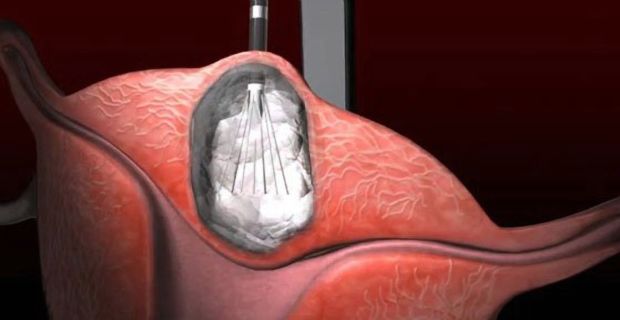Uterine fibroids are noncancerous growths of the uterus. They often appear during the childbirth years [1]. They are also called myomas or leiomyomas. They are not associated with an increased risk of uterine cancer. Uterine fibroids almost never develop into cancer. They can range in size from seedlings which are undetectable by the human eye, to bulky masses which can distort and enlarge in the uterus. Someone can have a single fibroid while other can have a multiple fibroids. In extreme cases, multiple fibroids can expand the uterus so much and this is reaching the rib cage. There are many women who have uterine fibroids sometime during their lives. But there are many women who do not know that they have uterine fibroids because they do not cause any symptoms. Your doctor can discover the uterine fibroids by a prenatal ultrasound or a pelvic exam.
Symptoms of uterine fibroids
There are many women who have uterine fibroids but they do not have any symptoms. In women who have uterine fibroids, symptoms can be influenced by size, location and the number of fibroids. In women who have symptoms [2], the most common symptoms of this condition include:
- Backache or leg pains
- Constipation
- Difficulty swallowing the bladder
- Frequent urination
- Pelvic pressure or pain
- Menstrual periods lasting more than a week
- Heavy menstrual bleeding
There are rare cases when the fibroid can cause acute pain when it outgrows its blood supply and it begins to die. Uterine fibroids are generally classified by their location. It is known fact that the intramural fibroids are growing within the muscular uterine wall. The submucosal fibroids bulge into the uterine cavity. The subserosal fibroids are projecting to the outside of the uterus.
Uterine fibroids causes
Doctors do not know the exact reason for uterine fibroids but there are some studies which are pointing to these factors:
- Hormones: The progesterone and estrogen, which are two hormones that are stimulating the development of the uterine lining during each menstrual cycle in preparation for pregnancy appear to promote the growth of fibroids. It is known fact that the uterine fibroids have more progesterone and estrogen receptors compared to the normal uterine muscle cells do. After the menopause, there is a decrease in the hormone production which is leading to shrinking of fibroids. [1,3]
- Genetic changes: There are many fibroids which have changes in genes which are making them different from those in the normal uterine muscle cells. [4]
- Other growth factors: There are some substances which can help the body to maintain tissues, such as insulin – like growth factor which can affect the fibroid growth. [5]
There are many doctors who believe that the uterine fibroids are developing from the stem cells in the smooth muscular tissue of the uterus (myometrium). A single cell divides repeatedly and it can eventually create a firm and rubbery mass distinct from the nearby tissue. The growth patterns of the uterine fibroids can vary, then can grow slowly or rapidly and also they can remain the same size. There are some fibroids which can go through growth spurts and these fibroids can shrink on their own. There are many fibroids which have been present during the pregnancy and they shrink or disappear after the pregnancy because the uterus goes back to a normal size.
Risk factors: There are some known risk factors for uterine fibroids, other than being a woman of reproductive age. Here are some other factors which can have an impact of the fibroid development:
- Environmental factors: There are some environmental factors which can increase the risk of developing uterine fibroid such as having a diet higher in red meat and lower in green vegetables, fruit and dairy; a Vitamin D deficiency; obesity; use of birth control and the onset of menstruation at an early age. [6]
- Race: There are some studies in which are said that black women are having higher chances of developing uterine fibroids compared to people from other races. [7]
- Heredity: It is known fact that if your mother or sister had uterine fibroids, then you have increased risk of developing them. [4]
References:
[1] Carpini GD, Morini S, Papiccio M, et al. The association between childbirth, breastfeeding, and uterine fibroids: an observational study. Scientific Reports. 2019.
[2] Eunice Kennedy Shriver National Institute of Child Health and Human Development. Uterine fibroids. Retrieved from www.nichd.nih.gov/health/topics/uterine
[3] Wong JYY, Gold EB, Johnson WO, Lee JS. Circulating sex hormones and risk of uterine fibroids: Study of women’s health across the nation (SWAN). The Journal of Clinical Endocrinology & Metabolism. 2016;101(1):123-30.
[4] Vastag B. Genes and uterine fibroids. JAMA. 2002;288(11):1342. doi:10.1001/jama.288.11.1342-JHA20009-4-1
[5] Hou ZM, Sun Q, Liu YZ, et al. Effects of insulin resistance on myometrial growth. International Journal of Clinical and Experimental Medicine. 2015;8(1):1552–7.
[6] Wise LA. Study of environment lifestyle and fibroids (SELF): Advancing the field of fibroid epidemiology. Journal of Women’s Health. 2015;24(11):862–4.
[7] Stewart EA, Nicholson WK, Bradley L, Borah BJ. The burden of uterine fibroids for African-American women: Results of a national survey. Journal of Women’s Health. 2013;22(10):807–16.





